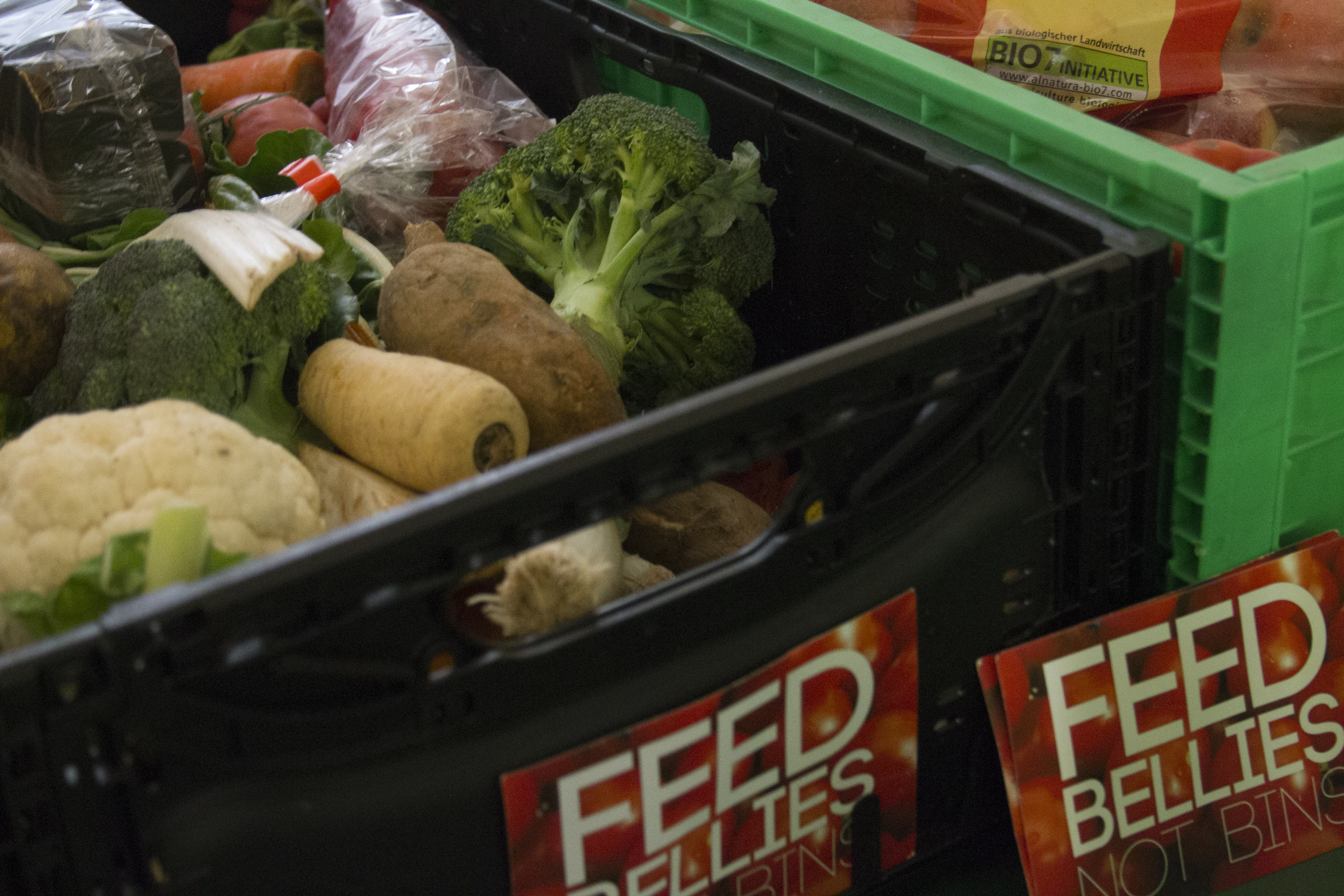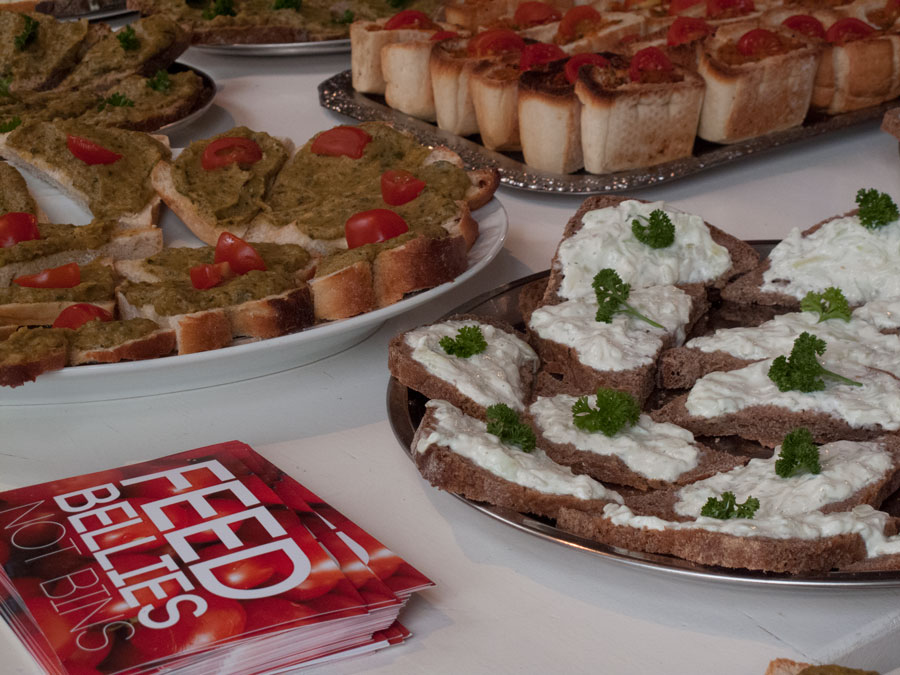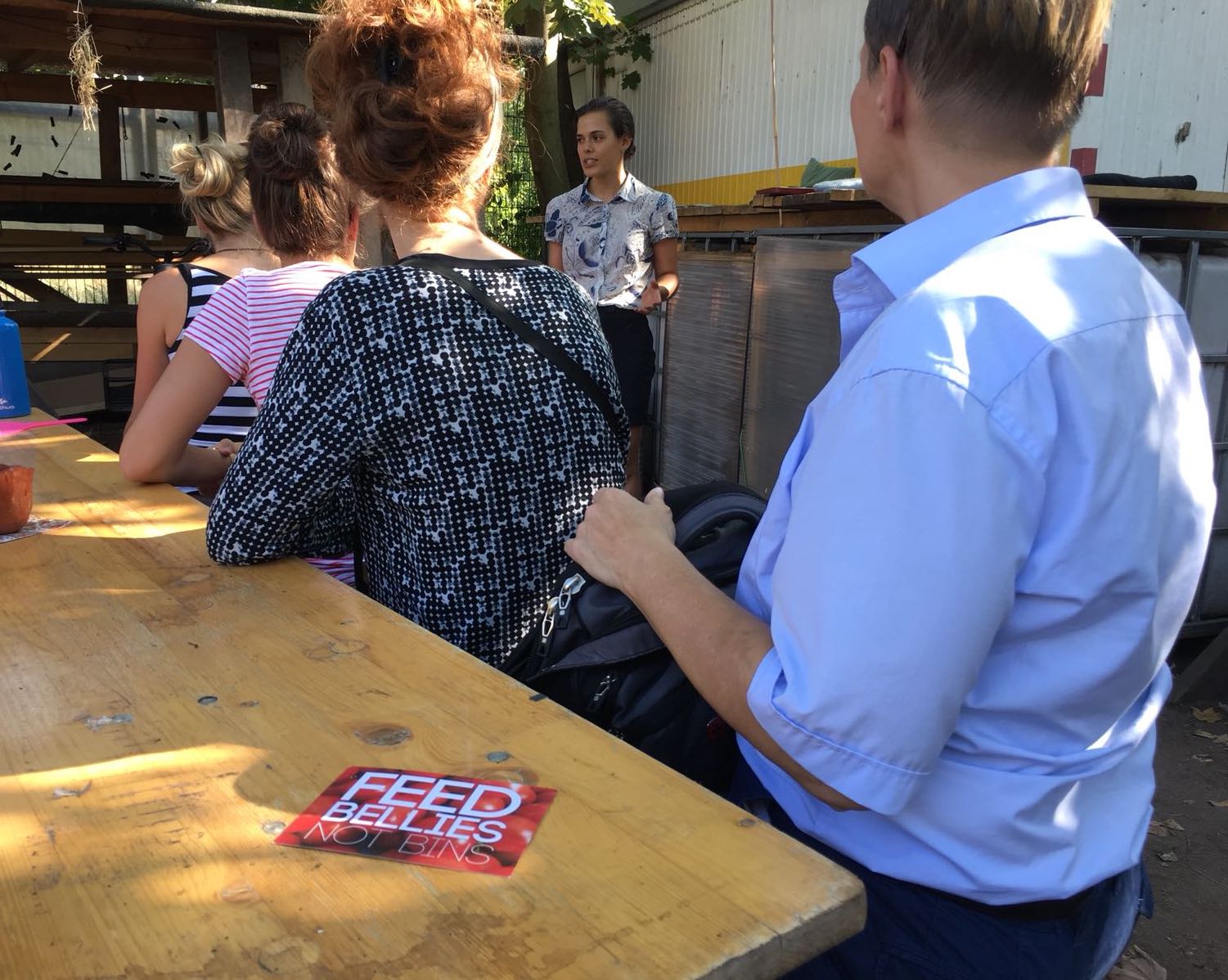I have been nurturing myself with the food that I save from the bio supermarket with The Real Junk Food Project in Berlin for around three years now. The way it works is that the supermarket seperates the food they are going to throw away for us. We then come in, sort what should REALLY be thrown away from what is still edible, take a few things that we need and prepare the rest to be redistributed. In Germany about 30% of the food produced is wasted. We make sure to minimize this as much as possible.

Foto from a workshop with the Real Junk Food Project Photograph: Elisa Winograd
For me the saving doesn't stop when I stroll out of the supermarket backdoors. I often redistribute the food on my lovely bike, which makes the transport easier and so much more fulfilling than depending on a car or the train. There are a few "fariteiler" in Berlin, which are places designated to leave food for anyone to take. They are run by another food saving organization called Food Sharing which admirebly makes sure that they are clean and taken care of. They are equipped with fridges, most of the time, and host a house for other items that people want to keep on circling around through others hands (i.e. clothes, books, etc.). Some are even hosted by community bars or cafes! If you are interesting in seeing which ones are available in Berlin click here.
Throughout the years I have helped with the food collections which are organized during the week. I have had the luck to form part of a constant team of passionate food savers that gather every saturday for this act of volunteering. Our meticulous team makes sure that nothing goes to the bin. Sometimes I even gather the left of seeds that have fallen off the bread loaves and use them as a crunchy and underrated salad topping. Lately to be more hygienic, I discovered that if I put them on my balcony, I provide a savory meal for the birds in the spring! Although the "fairteiler" offer a great back up solution for the food that is left over, we feel more consciously sound when we are able to distribute the food to people who are guaranteed to responsibly make use of it. Neighbors, friends and sometimes Homeless shelters form a part of this network. Bunnies and their farm friends have also the opportunity to enjoy the leaves that would otherwise fill the brown containers of food which will be burned by the state for energy. Because this food is already in its second stage of life, it is like a fragile porcelain glass which must be handled with care before it reaches its end. I therefore always cross my fingers and hope that the people who get their hands on these unappreciated gifts of the Earth are able to make use of them and not let them end up in their predetermined destiny. With so much care, I regardless sometimes end up having to throughout a leaf or two and dispose of items which, although not even ripe, won't find their tasty way out alive. In this journey, I have learned a few valuable techniques that have helped me prolong the life of particular food items. I would like to share these with you:
- Reviving salad leaves and others: Soak the loose leaves in water for a few hours, or overnight. Watch how the leaves slowly revive! Store in a cloth inside the fridge.
I am always surprised at how much the leaves that are soft and wanky grow to be beautiful and lively again. You can do this with all types of leafy greens. The items I have tried are: Cabbage (red or green), Salad (of all kinds), Spinach, Carrot greens, Mangold, etc. If the leaves were very sad and dehydrated to begin with, make sure you consume them as fast as possible. Nevertheless, they should last a few days at least with the damp cloth in the fridge. I have even made sauerkraut and other ferments with the cabbage that I soaked and revived. - Storing carrots and root veggies: I have never tried this myself but I got a tip from a farmer once: Carrots and root veggies, like beetroot, can be stored in a container full of sand for an entire winter!
- Cutting off the ugly parts: Some people have a rule of thumb: if the veggie or fruit has a lot of water (oranges, cucumber, etc.), mold in one section probably means it is in the entire food item. My rule of thumb: Cut all the ugly parts of the fruit or veggie when still brown (before it molds), store in the fridge and eat as soon as possible. If mold has already developed, cut off the moldy part and a generous part around it.
If you observe the fruit of veggie closely once cut and see signs of unfreshness, cut of the piece that doesn't look right. If you have very good taste buds you can probably make a decision trusting these. From my experience, I have noticed that veggies with a thick and hard skin (like beetroot) are usually fine in the inside if there is a little bit of mold out the outside. In this case it also helps to clean off the mold and store it in the fridge with the plan to it as soon as possible. Use your best judgement and eat what makes you comfortable but always ask: is it really bad or I am judging only with my rationality and preperceptions. - Making bread fresh again: The best way to store bread is to freeze it as soon as possible while still fresh. You should slice it and place it in a tightly sealed plastic bag. When freezing is not possible, or not necessary, store the bread in a plastic bag. Paper absorbs the bread's moisture and dries it out. Beware! If you are camping or in humid conditions, make sure the bag doesn't trap moisture or the bread will mold! If the bread dries out, there is no need to throw it away! You can simply sprinkle it with a few drops of water (or oil), put it in the oven and it will be fresh again. I haven't tried this but I am sure if you give it some water and let it sit for a few hours, it will become fresh without the help of the oven.
If the bread is completely dry and almost inedible, there are a few more things you could do with it if you are a culinary trooper. The Project once donated dry loaves of bread to a brewery to make beer, it was delicious! You can also make Kvass (a Russian fermented drink) and other fun things. I haven't tried these. I used to soak old bread in the past and use it as a base for making a quiche. Experiment, have fun, and write to me if you need inspiration!
Something valuable I have learned while working with this project is not to judge the food I buy by its appearance. Sometimes we pick things in the grocery store, making sure that they are the best looking, which is understandable because we are paying for the food and we don't want to pay for something that is not absolutely fresh. Sometimes it's worth it, however, to pick the items that probably no one else will pick if you know you will consume them in the next few days. Some stores offer these items with a discount but I haven't seen enough that do that. A good tip if you eat a lot of salad and want to save money: ask at your grocery store if they have any leafy greens they will throw out! Most people prefer to buy their veggies without some of their most nutritional parts (the leaves of the carrots have more vitamins that the root itself, for example). See this blog post to learn more. It never hurts to ask and to try something new in your salad! More veggies and fruits are also actually healthier the more ripe they are (like bananas, the browner the better).

Catering event with the Project 2017 Photograph: Elisa Winograd
What inspired me initially to write this post was the buntness in my meals since I started working with this project. It has certeinly changed my eating habbits, inspired me to try to new things and shown me the value of many local veggies I had never tried before. I sometimes wonder if I would have even tried some of the veggies if not having saved them from being thrown away. It also makes me even more concious of how food travels around the world and how the taste is altered depending on if it came from thousands of kilometers away or if it was grown closer by. I am thankful for many things about this opportunity but most importantly for being able to try to save the food that is getting wasted every week.

Representing the Project in a Circular Economy Tour Photograph: Elisa Winograd